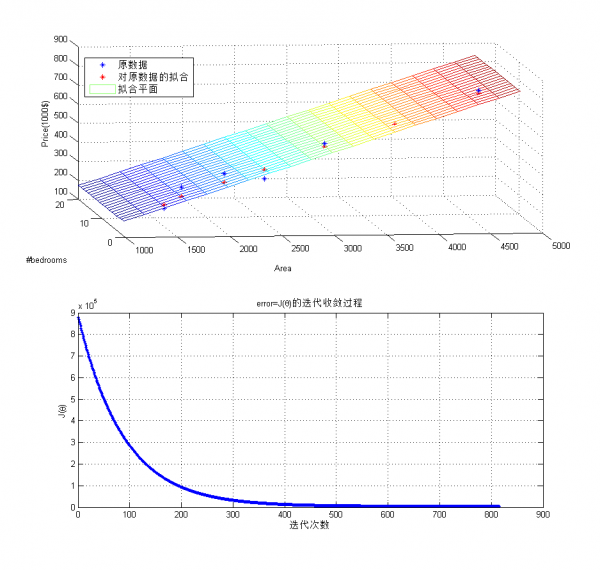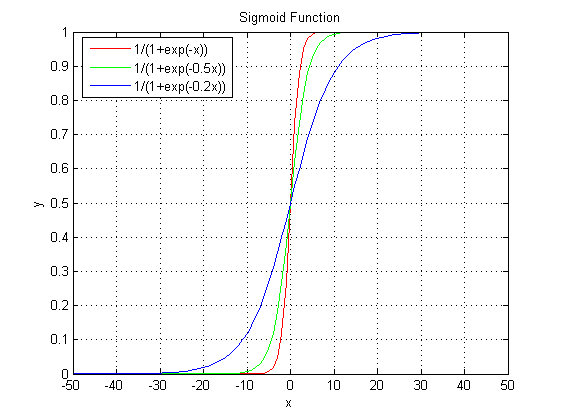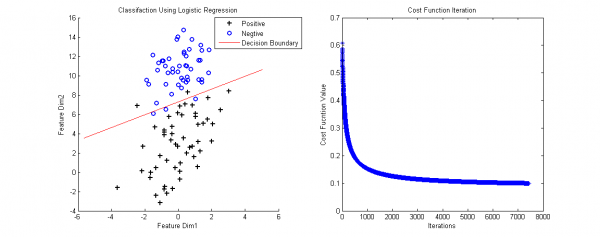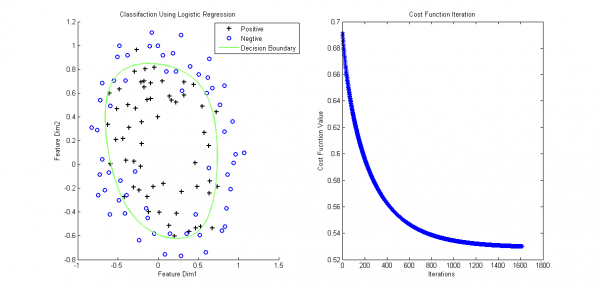Stanford机器学习课程的主页是: http://cs229.stanford.edu/
主讲人Andrew Ng是机器学习界的大牛,创办最大的公然课网站coursera,前段时间还听说加入了百度。他讲的机器学习课程可谓每一个学计算机的人必看。全部课程的大纲大致以下:
本笔记主要是关于Linear Regression和Logistic Regression部份的学习实践记录。
举了1个房价预测的例子,
| Area(feet^2) | #bedrooms | Price(1000$) |
|---|---|---|
| 2014 | 3 | 400 |
| 1600 | 3 | 330 |
| 2400 | 3 | 369 |
| 1416 | 2 | 232 |
| 3000 | 4 | 540 |
| 3670 | 4 | 620 |
| 4500 | 5 | 800 |
Assume:房价与“面积和卧室数量”是线性关系,用线性关系进行放假预测。因此给出线性模型, hθ(x)?=?∑θTx ,其中 x?=?[x1,?x2] , 分别对应面积和卧室数量。 为得到预测模型,就应当根据表中已有的数据拟合得到参数 θ 的值。课程通过从几率角度进行解释(主要用到了大数定律即“线性拟合模型的误差满足高斯散布”的假定,通过最大似然求导就可以得到下面的表达式)为何应当求解以下的最小2乘表达式来到达求解参数的目的,
上述 J(θ) 称为cost function, 通过 minJ(θ) 便可得到拟合模型的参数。
解 minJ(θ) 的方法有多种, 包括Gradient descent algorithm和Newton's method,这两种都是运筹学的数值计算方法,非常合适计算机运算,这两种算法不但合适这里的线性回归模型,对非线性模型以下面的Logistic模型也适用。除此以外,Andrew Ng还通过线性代数推导了最小均方的算法的闭合数学情势,
Gradient descent algorithm履行进程中又分两种方法:batch gradient descent和stochastic gradient descent。batch gradient descent每次更新 θ 都用到所有的样本数据,而stochastic gradient descent每次更新则都仅用单个的样本数据。二者更新进程以下:
batch gradient descent
stochastic gradient descent
for i=1 to m
二者只不过1个将样本放在了for循环上,1者放在了。事实证明,只要选择适合的学习率 α , Gradient descent algorithm总是能收敛到1个接近最优值的值。学习率选择过大可能造成cost function的发散,选择太小,收敛速度会变慢。
关于收敛条件,Andrew Ng没有在课程中提到更多,我给出两种收敛准则:
下面是使用batch gradient descent拟合上面房价问题的例子,
clear all;
clc
%% 原数据
x = [2014, 1600, 2400, 1416, 3000, 3670, 4500;...
3,3,3,2,4,4,5;];
y = [400 330 369 232 540 620 800];
error = Inf;
threshold = 4300;
alpha = 10^(-10);
x = [zeros(1,size(x,2)); x]; % x0 = 0,拟合常数项
theta = [0;0;0]; % 常数项为0
J = 1/2*sum((y-theta'*x).^2);
costs = [];
while error > threshold
tmp = y-theta'*x;
theta(1) = theta(1) + alpha*sum(tmp.*x(1,:));
theta(2) = theta(2) + alpha*sum(tmp.*x(2,:));
theta(3) = theta(3) + alpha*sum(tmp.*x(3,:));
% J_last = J;
J = 1/2*sum((y-theta'*x).^2);
% error = abs(J-J_last);
error = J;
costs =[costs, error];
end
%% 绘制
figure,
subplot(211);
plot3(x(2,:),x(3,:),y, '*');
grid on;
xlabel('Area');
ylabel('#bedrooms');
zlabel('Price(1000$)');
hold on;
H = theta'*x;
plot3(x(2,:),x(3,:),H,'r*');
hold on
hx(1,:) = zeros(1,20);
hx(2,:) = 1000:200:4800;
hx(3,:) = 1:20;
[X,Y] = meshgrid(hx(2,:), hx(3,:));
H = theta(2:3)'*[X(:)'; Y(:)'];
H = reshape(H,[20,20]);
mesh(X,Y,H);
legend('原数据', '对原数据的拟合', '拟合平面');
subplot(212);
plot(costs, '.-');
grid on
title('error=J( heta)的迭代收敛进程');
xlabel('迭代次数');
ylabel('J( heta)');拟合及收敛进程以下:

不论是梯度降落,还是线性回归模型,都是工具!!分析结果更重要,从上面的拟合平面可以看到,影响房价的主要因素是面积而非卧室数量。
很多情况下,模型其实不是线性的,比如股票随时间的涨跌进程。这类情况下, hθ(x)?=?θTx 的假定不再成立。此时,有两种方案:
其中权值的1种好的选择方式是:
Linear Regression解决的是连续的预测和拟合问题,而Logistic Regression解决的是离散的分类问题。两种方式,但本质殊途同归,二者都可以算是指数函数族的特例。
在分类问题中,y取值在{0,1}之间,因此,上述的Liear Regression明显不适应。修改模型以下
该模型称为Logistic函数或Sigmoid函数。为何选择该函数,我们看看这个函数的图形就知道了,

Sigmoid函数范围在[0,1]之间,参数 θ 只不过控制曲线的峻峭程度。以0.5为截点,>0.5则y值为1,< 0.5则y值为0,这样就实现了两类分类的效果。
假定 P(y?=?1|x;?θ)?=?hθ(x) , P(y?=?0|x;?θ)?=?1???hθ(x) , 写得更紧凑1些,
对m个训练样本,使其似然函数最大,则有
一样的可以用梯度降落法求解上述的最大值问题,只要将最大值求解转化为求最小值,则迭代公式1模1样,
最后的梯度降落方式和Linear Regression1致。我做了个例子(数据集链接),下面是Logistic的Matlab代码,
function Logistic
clear all;
close all
clc
data = load('LogisticInput.txt');
x = data(:,1:2);
y = data(:,3);
% Plot Original Data
figure,
positive = find(y==1);
negtive = find(y==0);
hold on
plot(x(positive,1), x(positive,2), 'k+', 'LineWidth',2, 'MarkerSize', 7);
plot(x(negtive,1), x(negtive,2), 'bo', 'LineWidth',2, 'MarkerSize', 7);
% Compute Likelihood(Cost) Function
[m,n] = size(x);
x = [ones(m,1) x];
theta = zeros(n+1, 1);
[cost, grad] = cost_func(theta, x, y);
threshold = 0.1;
alpha = 10^(⑴);
costs = [];
while cost > threshold
theta = theta + alpha * grad;
[cost, grad] = cost_func(theta, x, y);
costs = [costs cost];
end
% Plot Decision Boundary
hold on
plot_x = [min(x(:,2))⑵,max(x(:,2))+2];
plot_y = (⑴./theta(3)).*(theta(2).*plot_x + theta(1));
plot(plot_x, plot_y, 'r-');
legend('Positive', 'Negtive', 'Decision Boundary')
xlabel('Feature Dim1');
ylabel('Feature Dim2');
title('Classifaction Using Logistic Regression');
% Plot Costs Iteration
figure,
plot(costs, '*');
title('Cost Function Iteration');
xlabel('Iterations');
ylabel('Cost Fucntion Value');
end
function g=sigmoid(z)
g = 1.0 ./ (1.0+exp(-z));
end
function [J,grad] = cost_func(theta, X, y)
% Computer Likelihood Function and Gradient
m = length(y); % training examples
hx = sigmoid(X*theta);
J = (1./m)*sum(-y.*log(hx)-(1.0-y).*log(1.0-hx));
grad = (1./m) .* X' * (y-hx);
end
判决边界(Decesion Boundary)的计算是令h(x)=0.5得到的。当输入新的数据,计算h(x):h(x)>0.5为正样本所属的类,h(x)< 0.5 为负样本所属的类。
这部份在Andrew Ng课堂上没有讲,参考了网络上的资料。
上面的数据可以通过直线进行划分,但实际中存在那末种情况,没法直接使用直线判决边界(看后面的例子)。
为解决上述问题,必须将特点映照到高维,然后通过非直线判决界面进行划分。特点映照的方法将已有的特点进行多项式组合,构成更多特点,
上面将2维特点映照到了2阶(还可以映照到更高阶),这便于构成非线性的判决边界。
但还存在问题,虽然上面方法便于对非线性的数据进行划分,但也容易由于高维特性造成过拟合。因此,引入泛化项应对过拟合问题。似然函数添加泛化项后变成,
此时梯度降落算法产生改变,
最后来个例子,样本数据链接,对应的含泛化项和特点映照的matlab分类代码以下:
function LogisticEx2
clear all;
close all
clc
data = load('ex2data2.txt');
x = data(:,1:2);
y = data(:,3);
% Plot Original Data
figure,
positive = find(y==1);
negtive = find(y==0);
subplot(1,2,1);
hold on
plot(x(positive,1), x(positive,2), 'k+', 'LineWidth',2, 'MarkerSize', 7);
plot(x(negtive,1), x(negtive,2), 'bo', 'LineWidth',2, 'MarkerSize', 7);
% Compute Likelihood(Cost) Function
[m,n] = size(x);
x = mapFeature(x);
theta = zeros(size(x,2), 1);
lambda = 1;
[cost, grad] = cost_func(theta, x, y, lambda);
threshold = 0.53;
alpha = 10^(-1);
costs = [];
while cost > threshold
theta = theta + alpha * grad;
[cost, grad] = cost_func(theta, x, y, lambda);
costs = [costs cost];
end
% Plot Decision Boundary
hold on
plotDecisionBoundary(theta, x, y);
legend('Positive', 'Negtive', 'Decision Boundary')
xlabel('Feature Dim1');
ylabel('Feature Dim2');
title('Classifaction Using Logistic Regression');
% Plot Costs Iteration
% figure,
subplot(1,2,2);plot(costs, '*');
title('Cost Function Iteration');
xlabel('Iterations');
ylabel('Cost Fucntion Value');
end
function f=mapFeature(x)
% Map features to high dimension
degree = 6;
f = ones(size(x(:,1)));
for i = 1:degree
for j = 0:i
f(:, end+1) = (x(:,1).^(i-j)).*(x(:,2).^j);
end
end
end
function g=sigmoid(z)
g = 1.0 ./ (1.0+exp(-z));
end
function [J,grad] = cost_func(theta, X, y, lambda)
% Computer Likelihood Function and Gradient
m = length(y); % training examples
hx = sigmoid(X*theta);
J = (1./m)*sum(-y.*log(hx)-(1.0-y).*log(1.0-hx)) + (lambda./(2*m)*norm(theta(2:end))^2);
regularize = (lambda/m).*theta;
regularize(1) = 0;
grad = (1./m) .* X' * (y-hx) - regularize;
end
function plotDecisionBoundary(theta, X, y)
%PLOTDECISIONBOUNDARY Plots the data points X and y into a new figure with
%the decision boundary defined by theta
% PLOTDECISIONBOUNDARY(theta, X,y) plots the data points with + for the
% positive examples and o for the negative examples. X is assumed to be
% a either
% 1) Mx3 matrix, where the first column is an all-ones column for the
% intercept.
% 2) MxN, N>3 matrix, where the first column is all-ones
% Plot Data
% plotData(X(:,2:3), y);
hold on
if size(X, 2) <= 3
% Only need 2 points to define a line, so choose two endpoints
plot_x = [min(X(:,2))-2, max(X(:,2))+2];
% Calculate the decision boundary line
plot_y = (-1./theta(3)).*(theta(2).*plot_x + theta(1));
% Plot, and adjust axes for better viewing
plot(plot_x, plot_y)
% Legend, specific for the exercise
legend('Admitted', 'Not admitted', 'Decision Boundary')
axis([30, 100, 30, 100])
else
% Here is the grid range
u = linspace(-1, 1.5, 50);
v = linspace(-1, 1.5, 50);
z = zeros(length(u), length(v));
% Evaluate z = theta*x over the grid
for i = 1:length(u)
for j = 1:length(v)
z(i,j) = mapFeature([u(i), v(j)])*theta;
end
end
z = z'; % important to transpose z before calling contour
% Plot z = 0
% Notice you need to specify the range [0, 0]
contour(u, v, z, [0, 0], 'LineWidth', 2)
end
end
我们再回过头来看Logistic问题:对非线性的问题,只不过使用了1个叫Sigmoid的非线性映照成1个线性问题。那末,除Sigmoid函数,还有其它的函数可用吗?Andrew Ng老师还讲了指数函数族。

上一篇 IP 分片丢失重传